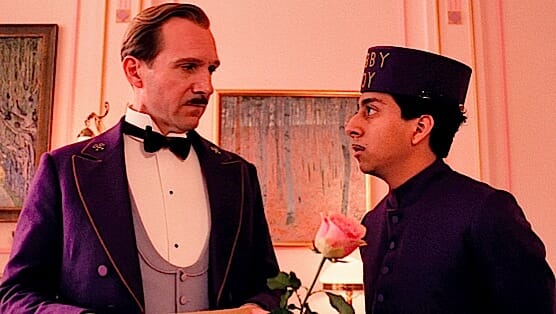The Grand Budapest Hotel

The colors in the lobby of Wes Anderson’s The Grand Budapest Hotel, a European luxury hotel in 1932, are pink, golden yellow and a plasma-colored red. The colors alone convey something majestic but raw. The film’s complex plot hinges on elaborate pastries in pink boxes tied with periwinkle ribbon from a legendary, and make-believe, shop called Mendl’s. (“Mendl’s is the best.”) These hourglass-shaped confections, stuffed with pastry cream and covered in pink and green fondant, seem to be a new type of pastry that exists entirely in Wes Anderson’s imagination. A film has not been so pink nor so dependent on pastel buttercream since Sofia Coppola’s Marie Antoinette.
The film begins with a framing device, as Anderson’s films almost always do. In this case, there are two. The film opens in 1985, and in the 1.85 aspect ratio most common today, with a young woman (looking like an Eastern Bloc cousin of Margot Tenenbaum) paying tribute to a statue of an honored author. She clutches a favorite book by this author, a novel called The Grand Budapest Hotel.
We next see the statue come to life, in the form of the author in his study, reading from index cards as Nabokov might have. He tells us how this book came to be written, which is a framing device typical of Stefen Zweig, an author Anderson cites as an influence in the credits. He tells a story in 1968, in 2.35 aspect ratio, of a younger version of the author (Jude Law) visiting the Grand Budapest Hotel when it’s past its prime and in the off-season. Walls are inexplicably half yellow and half pink, in midst of some repair or another. He explains how there he met an elegant old man named Zero Moustafa, once extremely wealthy but who now owns the hotel and little else. Moustafa dines well, sleeps in what looks like servant’s quarters, and seems slightly haunted. He tells the young author his story of how he came to befriend and be guided by the hotel’s greatest concierge, M. Gustave (also the name of a new chapter, with a gorgeous, bright red title card that looks almost hand-lettered). This brings us into 1932, which is in a 1.33 square aspect ratio. There, Ralph Fiennes plays this roguish, fastidious hero with a darting, snake-like charm.
The Grand Budapest Hotel is not in Budapest. It’s in the former republic of Zubrowka, a mountainous European nation that seems to be a sister state of Lubitsch’s Flausenthurm (from The Smiling Lieutenant) or Marshovia (The Merry Widow). These fake nations are also likely in league with Cracked Nuts’ El Dorania and, most famously, Duck Soup’s Freedonia. All of these films were released between 1931 and 1934, and the main action in Wes Anderson’s homage takes place in 1932. Why this time period? After the mass deaths of the first world war, Twentieth Century trauma and loss affected everything familiar, so imaginations sought escape in untainted, made-up places. (Not quite utopias, these countries usually featured an uneasy mix of fallen royalty, impossible bureaucracy and wandering livestock.)
Anderson’s between-the-war setting then seems to refer to both world wars, the first in tone and the second in plot, as menacing soldiers in black shirts threaten our hero, Gustave, and his old world ways, as well as the stateless orphan, Zero. The film might be called a post-Marie Antoinette period piece in its rich and unorthodox approach to history as autobiography.
-

-

-

-

-

-

-

-

-

-

-

-

-

-

-

-

-

-

-

-

-

-

-

-

-

-

-

-

-

-

-

-

-

-

-

-

-

-

-

-








































